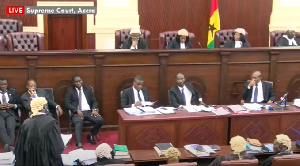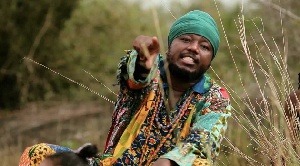Opinions of Monday, 27 November 2023
Columnist: Dr. Peter M. Dzidza
Congratulations to the people of Avenor
I write to congratulate the people of Avenor for their fifth-anniversary celebration of the “Avenor Tutudoza”, which commemorates the migration of the Avenor from Notse under the leadership of Torgbi Dorglo Anumah the First, who made a firm commitment to associate and move alongside the people of Agu to the middle belt of Tsevie in the Republic of Togo. That firm and decisive stance undergirds Avenor's history and differentiates it from others.
On this momentous occasion that reaffirms the unique identity of Avenor, let me especially appreciate Torgbui Dorglo Anumah the Fifth, The Paramount Chief and the President of Avenor Traditional Council, Hon. Bernard Ahiafor, Member of Parliament, Akatsi South and Elder JK Hogle for their selfless devotion and monumental contributions which made Avenor to have their traditional council, despite numerous protestations from known authorities.
This is so, because on the 14th of December, 2017, when the Avenor Traditional Council was about to be inaugurated, a fundamental and avoidable erroneous impression was created in the vain attempt to downgrade and discredit Avenor. There was a strong protest from some members of the Anlo Traditional Council, including the Awoamefia Torgbui Sri the Third.
According to them, just as Ave, Dzodze, Fenyi, Aflao, Klikor, Some, Afife, and Wheta (which were originally independent Ewe states in the southeastern part of the Volta Region) “belonged” to the Anlo Traditional Council, so must Avenor too. This erroneous impression and baseless agitation (which has been spearheaded by the Anlo Traditional Council ever since) emanated from the discredited Crowther Commission’s report, which erroneously used river Tordzi as the boundary between Avenor and the Tongue and it was later pointed out to him that the land at the west of river Tordzi and the various settlements like,
Tordzinu, Xikpo and Agbakorpe belong to Avenor.
Doubtless, Commissioner Crowther himself was said to have suffered from a conflict of conscience but failed to resolve issues or make amends. As such, this same discredited report became the basis for transforming the Anlo Confederation into the Anlo State Council in 1913, which later metamorphosed into the Anlo Traditional Council.
History doesn’t support this line of action because, before the Crowther Commission’s report, there was the Anlo Confederation. Not much was known about the history behind the formation of the Anlo Confederation at that time, but it is an undeniable fact that it was a loose alliance of pre-existing independent Ewe states in the southeastern part of the Volta Region. It had existed before the advent of British colonial rule and was described as “a loose coalition of
sovereign Ewe states which came together against external aggressors whenever the need arose”.
As such, it was also qualified as “a break-or-join alliance of various independent Ewe states in the south-east”. For instance, in the “Nonobe War” of 1750, the Avenor enclave broke away from Anlo and fought on the side of the Ada coalition that was pitted against Anlo. History has it that in 1767, Avenor joined the military coalition of Ada, Krobo, Agave, Mafi, and Tefle to fight Anlo and Akwamu. Indeed, during the Anlo-Ada War of 1769, Avenor promised assistance to both warring parties of Anlo and Ada but joined Anlo in the battle to win a decisive victory.
Circumstances changed for the worse thereafter, though. The fragile relationship that had existed between the two independent Ewe states (that is, Avenor and Anlo) later became tense when an Anlo migrant seduced one of the wives of the Avenor military commander. This led to the Akor or Anyamakpa war, which was fought between Anlo and the Avenor without the involvement of allies. The Avenors were heavily defeated. To ensure peace and restore normalcy, these two independent Ewe states agreed to sign a blood pact, referred to as “Dzonyinyi”.
According to Torgbi Yakagbe Gawuga the Second, a renounced chief of Atorkor in Anlo, the terms of the blood pact allowed the Avenor to subscribe to some of the
Anlo customs and traditions, for instance, the submission of criminals to the “Fifth Landing Stage” (“Torkor Atorlia”) and the right of appeal at Anloga for Avenor citizens facing criminal prosecution at the court of the paramount chief of Avenor.
However, the “Sagbadre War” of 1784 changed the dynamics. Its impact on the Anlo
confederation cannot be over-emphasized. This war, which was fought by the large Danish military coalition of Ada, Akyem, Akwapim, Accra, Krobo, Anexor, and the Danes against the Anlo, rekindled the consciousness of the Ewe states in the southeast for a stronger and more unified Anlo polity, which they believed would be distinct from the loose Anlo confederation. Besides, the spectacle of the large Danish coalition attacking Anlo had bound some neighboring Ewe states including Avenor to Anlo.
According to Torgbi Yakagbe Gawuga the second, it was the Anlo Confederation that was transformed into the Anlo State Council in 1913, based on the Crowther Commission’s report. Besides, in attempting to resolve the lingering land disputes between the people of Anlo and their neighbours (including the Avenor, the Tongu, and the Ada enclaves), is believed that the Crowther Commission was a deliberate instrument used by the British colonial administration to impose the Anlo paramountcy on the rest of the sovereign Ewe states for easy implementation of its “Indirect Rule” policy in the independent Ewe states in
the south-east.
To this end, the Commission created the Anlo State Council (using the
Awoamefia as its overlord) with its membership based on the pre-existing Anlo
Confederation, which was a voluntary and loose association of various autonomous Ewe states in the south-east. Other schools of thought, however, had different viewpoints because they believed that the choice of the Anlo polity as an indigenous overlord was influenced by two main factors:
It is the most aggressive and assertive “authority” among the independent Ewe states, and (ii) its leader is a young and educated reformist who was a close friend of Philip Crowther. Doubtless, the claim can be made that it was the creation of the Anlo State Council that subsumed the identities of the pre-existing independent Ewe states in the southeast, forcing them to relinquish their authority and autonomy to the Anlo paramountcy.
Regardless of the implications of the Crowther Report, the difference between the Avenor and the Anlo in terms of the settlement, migration route, clan, and leadership among others, cannot be over-emphasized as these differences were woven into “Atrikpui”, “Zokpo”, and “Kpegisu” songs to recount the struggles and the heroism exhibited by their forebears to get them a place they now call home.
According to Mr. Simon Kuegbala Gago (an elder of Avenor), the Avenor are also the components of Adja-Ewe people who migrated from Egypt to Ethiopia, then Sudan, and finally settled in a suburb of Ketu called Ketukpe. Currently, they are one of the largest Ewe polities in the southeastern part of present-day Ghana.
Due to incessant attacks on the Adja-Ewes by the Yoruba, the Ewes at Ketu (including Ketukpe) decided to move to a new home. Those of Ketukpe were no exception as they were led by Torgbui Agbohlo to Dogbonyigbo where Togbui Agbohlo died and his son Anumah finally led the Avenor to Notse in the republic of Togo.
During the great exodus from Notse, the Avenor under their leader Anumah, moved closely with the Agus, with whom they founded their first settlement called “Volui” at Avenor-Agu near Kpalime, in the Republic of Togo. Here, Torgbui Anumah crossed the mountain and made his second settlement at Anyirawase - Awudome. However, tribal frictions and conflicts over farmland with the people of Awudome made the Avenor move to Dorfor in North Tongu, where they settled at a place called Fodzoku. In search of a permanent place to call home, Torgbui Anumah and his group crossed the Volta River to Kroboland and founded a
settlement at Kpong. They later became known as Avenor-Krobos. This is still sung in songs and dirges.
However, frequent clashes between the Akwamus and the Krobos forced the Avenors to leave. Here, the Torgbui Anumah group was divided into two. The first group went south-west and founded a settlement among the Ga-Adangbe near Tesano in Accra, which they named Avenor. The larger group led by Torgbi Anumah wandered further southeast and founded a settlement on Fieve land on the bank of the Volta River and named it Tefle–Avenorkpo, which still stands.
At Avenorkpo in Tefle, there were frequent quarrels over farmland and fishing zones among the new settlers (namely, the Avenor and the original occupants of Tefle). This tension made the Avenor look far afield for another settlement. They crossed the Volta River to found a new settlement at Yorta near Dabala, later called Detsowome. At Yorta, the dreams of the Avenor were shattered when a deformed child (with one arm and one eye was born).
According to the customs and traditions of Avenor, a deformation of that kind, from birth, was an abomination, a harbinger of tragedy, hence the saying "Detsagbawor" (a typical Avenor word meaning “what a strange thing that has befallen us?”). This “Detsagbawor” was later corrupted to mean Detsawame. As a result, the Torgbui Anumah group decided to move out of Yorta further south, where they founded a new settlement called Adume, near Avenorpedo. At Adume, Torgbui Anumah died and his son Atsu Fiadzea succeeded him. Unfortunately, the nearest source of water for the new settlers at Adume was Lotor which was a long distance away.
The “disappearance” of women and children who went to Lotor to fetch water but didn’t return home, caused much anxiety, especially when they were said to have been kidnapped. This terrifying happening led to the area being named Lotor-Latsi, meaning "you will come but not return". These unfortunate incidents forced the Avenor, under their new leader Atsu Fiadzea, to move away to a place of safety later known as Korvenu, which Mr. Simon Kuegbala Gago refers to as “the grove that protects”. At Korvenu the Avenor fought many battles, including
the “Akor” or the “Anyamakpa” war. That battleground is currently traceable to Korvenu, where it is known as “Ametawito”, meaning the "pit of skulls".
The history of the Avenor entity is replete with many accounts of bravery and the determination of people bent on coming into their own, regardless of the obstacles put in their way by their detractors. As a result of the series of wars fought at Korvenu, the Avenors had to abandon their settlement to find a new home at Agbiveme also known as Afeyeme (new abode). Here, their leader Atsu Fiadzea died and was succeeded by his son Adoe under whom the Avenors made their permanent home at Avenorpeme.
On their arrival at Avenorpeme in 1776, the famous hunters and warriors such as Torgbi Tete Gefu and his son Torgbui Letsa Korba and others began expanding their new territory by annexing and acquiring the adjoining lands through conquests. In the end, thirteen (13) clans were identified and confirmed as legitimate spokes for the Avenor umbrella. These are Fiato, Wugbeme, Awasiapedome, Agbevie, Atsiame, Deme, Kpogedi, Atsite, Lume, Seviawo, Gbodome, Agornu and Adrovie. These clans were (and still are) unique in their totemic representation and are distinct from the 15 clans of Anlo, making it impossible for Avenor to be considered and classified among the Anlo states as a vassal entity to be bullied or coerced. Avenor has walked the tightrope of history to come into its own and cannot be subdued.
To conclude, it is evident that just as the Anlo, Asogli, and the Awudome states existed as independent and sovereign Ewe “states” in the past and still do so in modern-day Ghana, so also can the Avenor state which also existed as an independent and sovereign state with its membership based on the thirteen clans of Avenor before the Philip Crowther Commission’s biased report which tried to create a centralized administration with the Awoamefia as its figure-head for the envisaged benefits of the “indirect rule” policy if ever implemented in the
then Gold Coast to take root among the independent Ewe states in the south-east.













